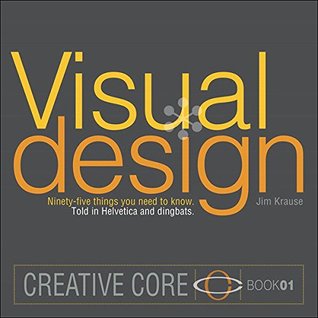Kindle Notes & Highlights
by
Jim Krause
Started reading
February 8, 2022
1 Proportional Considerations 2 Defining Boundaries 3 Margins 4 Columns 5 Grids 6 Defying the Grid 7 Backdrops 8 Backdrop Panels 2. Filling Spaces 9 Dynamic Spacing 10 Static Placement 11 Symmetry vs. Asymmetry 12 Aligning, and Not 13 The Golden Ratio 14 Over and Under 15 Alternative Orientations 16 Minimalism
Layouts are like stages. The images, headlines, text, graphics, logos, patterns, and colors that fill layouts are like characters on a stage. It’s up to the designer to decide where each character is to be placed, which ones are to play leading roles, and which are to provide support.
Dotted, doubled, tripled, ornate, or hand-drawn lines can function nicely as bordering elements.
Boundaries can be precisely defined and rigorously enforced.
Columns—as you probably know—are the invisible vertical containers commonly used to hold a layout’s text, images, and decorations in an orderly manner.
Many layouts and illustrations are presented directly against a white piece of paper or the white of a digital display. And why not? White can provide the perfect setting for an ad, an article, a Web page, a poster, a logo, or an illustration.
Hue is just another word for color. Blue, yellow, and red are hues, as are green, orange, violet, chartreuse, salmon, periwinkle, and pumpkin.
Saturation refers to the intensity—or the purity—of a hue. A fully saturated hue is a color in its most intense and pure state. Muted or grayed-out versions of hues have lesser levels of saturation.
Fonts can be divided into six main categories: serif, sans serif, script, blackletter, novelty, and dingbat.
Serif (also called Roman) typefaces—as their name suggests—have serifs. Serifs are rectangular, tapered, pointed, rounded, straight, arched, thin, thick, or blocky shapes projecting from the end of a letter’s stroke(s).
Sans serif fonts are without serifs and are usually made from strokes of the same width.
Script typefaces are usually broken down into two sub categories: formal and casual.
Blackletter fonts are based on the heavy, angular calligraphic letterforms often seen in manuscripts from the 12th to 17th centuries.
Dingbat and ornament fonts are composed of symbols, decorative designs, and illustrations.
We’ve all heard the phrase, It’s not what you say, it’s how you say it. A similar sentiment applies to typography:
Designers must learn to see the differences between fonts and to hear the inflections that arise from various typefaces in order to choose ones that are able to clearly communicate not only their layouts’ literal messages, but their desired thematic inferences as well.
choices involving kerning and leading.
Clumsy or inconsistent letterspacing, on the other hand, are surefire ways of undermining the aesthetic qualities of any logo or headline you create—no matter how well structured, colored, or crafted any of its other visual elements may be.
Never take your computer’s default letterspacing for granted. Question everything
First of all, just to be clear, a theme—as it’s being discussed here—is a quality, a feeling, a purpose, or an idea that pervades a layout, a logo, an illustration, or a photograph. Virtually all notable works of design and art are built around a theme of some kind or another. A theme can be subtle and pedestrian, or it can be audacious and moving—it all depends on the message you’re aiming for.
Sometimes, however, it’s the associations between dissimilar visual elements that do a piece’s theme-generating work—as when, for example, a photograph’s lovely content is overlaid with a crudely rendered, graffiti-like headline to convey notions of rebellion or satire.
as you work on layouts, be mindful of the many ways in which your piece’s thematic projections can be altered by making adjustments to one, some, or all of your piece’s components in terms of their style, size, position, and/or color.
If, for example, you are working on a design that’s meant to come across as moderately extroverted, try pushing the look of your layout to the point where it starts to go a bit overboard:
What is juxtaposition? It’s when two or more things that aren’t normally seen with each other are placed together
to generate thematic conveyances like weirdness, humor, mystery, cynicism, or social commentary.
Once you’ve identified your piece’s target audience, take the time to investigate the media—the magazines, videos, books, websites, and more—that these people look at.
74 Brainstorming
Begin with words. Why words? Words are easy to conjure and quick to record, and when they are received in the synapses of creative minds, they very often explode into fireworks of imagery and ideas.
Start by writing or typing nouns related to the subject matter you will be dealing with for the logo, layout, or illustration you’re working on
Use the Web and a thesaurus to help fill your sheet(s) of paper with as much material possible.
Next, look at everything you’ve written down and let each word and sentence resonate, one by one, in your creative and resourceful brain.
Balloons plus birds, for example, or bees plus automobiles, or head plus lightbulb plus sparkles.
Make quick thumbnail sketches of any and all potentially useful ideas that arise
A small amount of stress—or, at the very least, an ambient sense of urgency—can help bring a sense of focus and purpose to the creative process.
Large-scale stress, on the other hand, is usually something to be avoided
banking ideas and it goes like this: Every so often, as you work, sit back and evaluate your thumbnails, and circle those that seem to have potential as winning ideas.
Question everything.
Refrain from patting yourself on the back momentarily, call upon the analytical and dispassionate recesses of your brain, and take a cold, hard look at the position, size, color, and stylistic aspects of every element of your creation.


